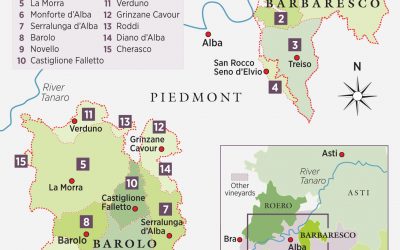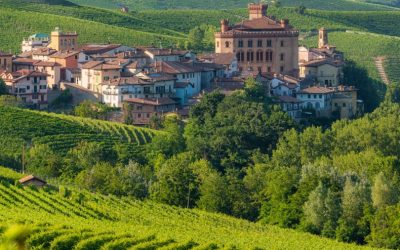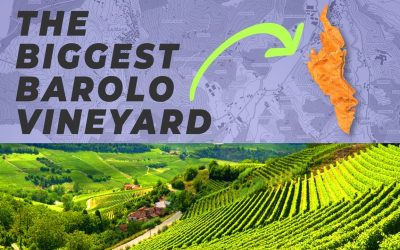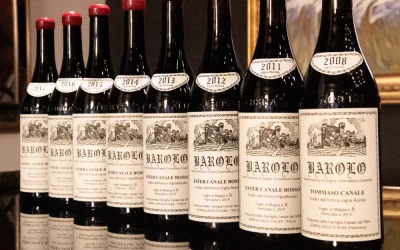What are the characteristics of Nebbiolo?
Nebbiolo, named for ‘nebbia’, the Italian word for fog, is an acclaimed red grape variety from Italy’s Piedmont region. It is highly prized for its ability to produce some of the country’s most prestigious and long-lived wines, including Barolo and Barbaresco. The thick-skinned Nebbiolo grape ripens late, often in mid to late October, around the time when the morning fog envelops the valleys of Piedmont, hence its name.
What are the characteristics of Nebbiolo?
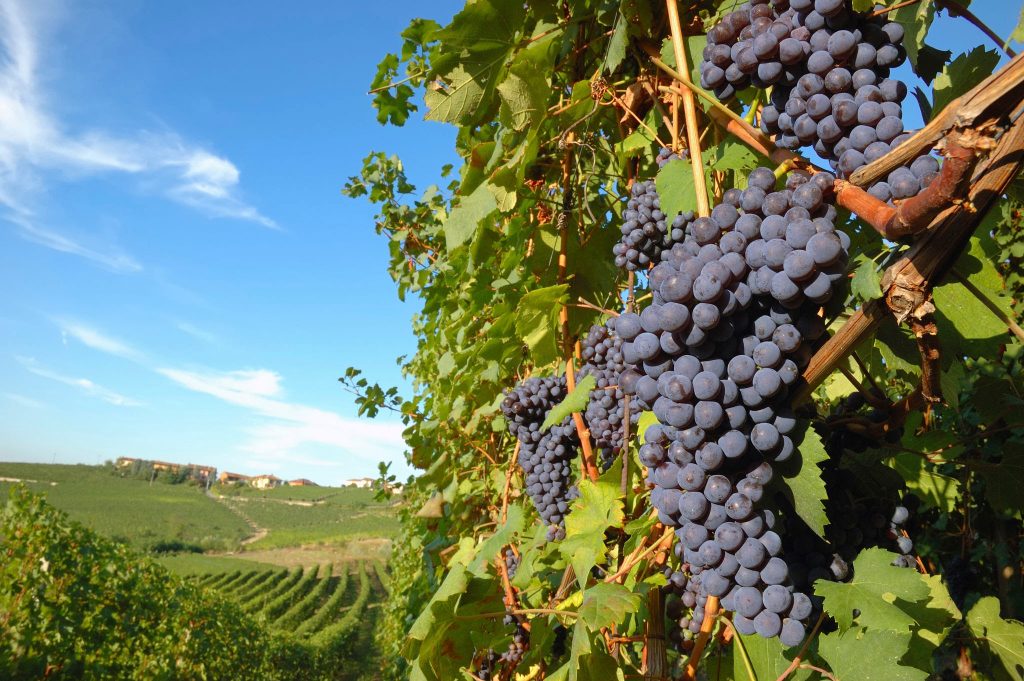
Nebbiolo, named for the Italian word ‘nebbia’ which means fog, is a grape that mirrors its native landscape, with its wines often carrying a misty, ethereal quality in their complex profile. Famed for its paradoxical delicate yet powerful expression, Nebbiolo is the driving force behind some of Italy’s most iconic wines, including Barolo and Barbaresco. Renowned for its high tannins and acidity, Nebbiolo presents an impressive structure and depth. These wines have the extraordinary ability to age, with some of the finest expressions capable of improving over decades. At its core, Nebbiolo carries concentrated flavors, often including red fruit notes of cherry, raspberry, and plum, which over time give way to secondary and tertiary aromas such as leather, tar, anise, and a distinct floral note of rose petal. Nebbiolo wines, especially from older vintages, are often described as having a ‘tar and roses’ scent. This alluring combination of power and finesse makes Nebbiolo a unique and highly regarded varietal in the world of wine.
As for aging Nebbiolo, its high tannin content and acidity make it a particularly age-worthy grape. While some Nebbiolo wines can be enjoyed young, most require at least a few years to mellow out their tannins and fully express their complex characteristics. In optimal cellaring conditions, a high-quality Nebbiolo wine can age and improve for several decades, with top Barolos and Barbarescos often reaching their peak 10 to 20 years after the vintage. While a young Nebbiolo can be vibrant, tannic, and full of primary fruit flavors, a mature Nebbiolo is an altogether different experience. With age, the wine’s high tannins soften, and the pronounced fruit character gives way to more nuanced flavors. The complexity of a mature Nebbiolo is unparalleled, with a rich tapestry of flavors that might include dried fruit, licorice, tobacco, leather, meaty notes, truffle, and even a hint of forest floor. The wine also tends to take on a characteristic brick-orange tinge at the rim of the glass.
The Barolo 2016 vintage has been recognized as an exceptional year for Barolo, producing some of the finest wines in recent memory. Optimal weather conditions have resulted in impeccably ripe Nebbiolo grapes, yielding wines with intense flavors, high acidity, and refined tannins. Notably, wines like those from the esteemed Elio Grasso estate exhibit potential for remarkable aging. As these wines evolve, they will continue to unravel the fascinating story of Nebbiolo, offering enthusiasts a unique opportunity to witness the metamorphosis of a young, robust Barolo into a mature, harmonious, and profoundly complex wine.
Key Points: Nebbiolo Characteristics
| Characteristic | Description |
|---|---|
| Grape Appearance | Small, round grapes with thick, dark skins |
| Growing Regions | Predominantly grown in Piedmont, Italy. Also found in Lombardy, Valtellina, and internationally |
| Wine Appearance | Lighter color even when young, turning to a brick-orange hue when aged |
| Aroma Profile | Aromas of roses, violets, cherries, truffles, and anise. Leather and dark fruits emerge as the wine ages |
| Taste Profile | High tannins and acidity with flavors of red cherries, raspberries, prunes, or dried fruit |
| Aging Potential | Exceptional, due to high tannins and acidity. Often aged in oak barrels |
| Food Pairings | Best paired with rich, hearty dishes like truffle-based dishes, risottos, red meats, and aged cheeses |
Nebbiolo – General Information on the Grape Variety
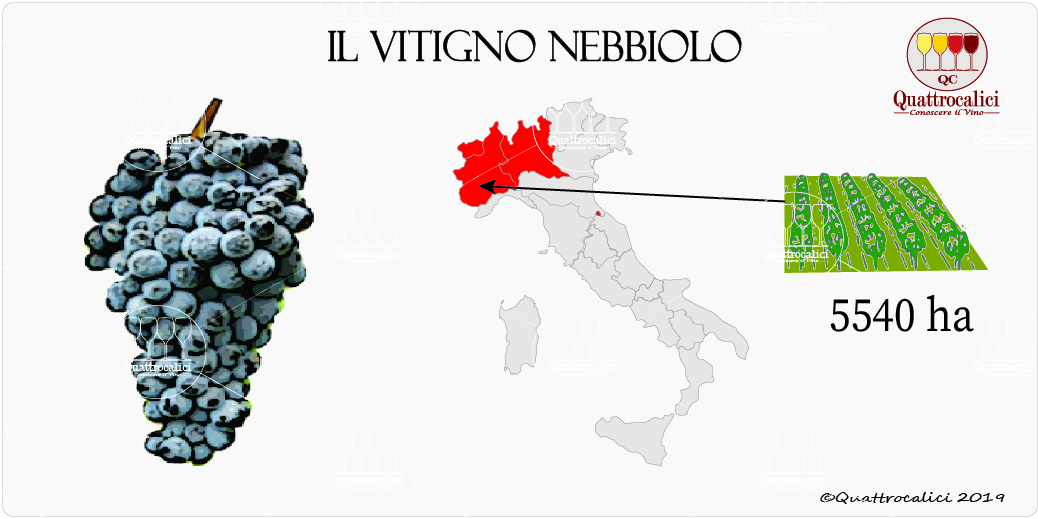
Nebbiolo is one of the indigenous red grape varieties predominantly found in the regions of Piedmont and Lombardy. It was officially registered in the National Grape Variety Catalogue in 1970. The total area of Nebbiolo cultivation nationwide amounts to 5,540 hectares.
| Nebbiolo Grape Information | |
|---|---|
| Grape Color | Black |
| Grape Category | Indigenous Varieties |
| Primary Italian Regions | Piedmont, Lombardy |
| National Viticultural Area | 5,540 hectares |
| Synonyms | Chiavennasca, Spanna, Picotendro, Prunent |
| Year of Registration | 1970 |
| Authorized Regions | Abruzzo, Lombardy |
| Observed Regions | Basilicata |
| Recommended Regions | Piedmont, Sardinia, Aosta Valley |
Nebbiolo, known by various names such as Chiavennasca, Spanna, Picotendro, and Prunent, showcases the rich diversity of Italian viticulture. Primarily cultivated in Piedmont and Lombardy, it also finds a home in other regions like Abruzzo and even as far afield as the Aosta Valley and Sardinia. Despite its limited national spread of 5,540 hectares, the variety’s unique attributes have solidified its status as one of the most distinguished and treasured grape varieties in Italy.
Physical Characteristics of Nebbiolo Grapes

The Nebbiolo grape, the star behind Barolo wines, possesses some distinctive physical characteristics that contribute to its unique flavor profile. These grapes are small to medium-sized with thick, dark blue-black skins, which are rich in tannins and anthocyanins, the compounds responsible for the intense color and structure in wine.
The Nebbiolo vine is known for its high vigor and is typically trained and pruned to manage its energy and focus on the fruit. Furthermore, it is a late-ripening variety, usually harvested in October, which allows for a longer growing season and the development of complex flavors and aromas in the grapes. This prolonged maturation is one of the reasons why Nebbiolo, especially from esteemed vineyards like Cannubi, can create such deep, intense, and long-lived wines.
Let’s delve a bit deeper into the physical characteristics of the Nebbiolo grape:
- Color: As mentioned earlier, Nebbiolo grapes are dark, with a color that verges on black-blue when they reach full ripeness. Despite this dark color, Nebbiolo grapes have a relatively low amount of pigmented compounds, known as anthocyanins, which contribute to the color of the wine. This results in wines that, despite coming from such dark-colored grapes, have a lighter, garnet hue that becomes more pronounced with age.
- Size and Shape: Nebbiolo grapes are typically small to medium in size, allowing for a greater skin-to-juice ratio. This high ratio contributes to the extraction of tannins during the winemaking process. The grapes are often tightly packed in a pyramid-shaped bunch, with a single shoulder.
- Skin: Nebbiolo’s thick skin is rich in phenolic compounds, particularly tannins. Tannins are a group of compounds that contribute to the texture of the wine, giving it a characteristic astringency and the potential for long-term aging.
- Leaves: The leaves of the Nebbiolo vine are large and have three lobes. They become yellow-orange in the fall before dropping off for winter dormancy. The leaves are a critical part of the vine as they aid in photosynthesis, the process that helps the vine produce the energy it needs to ripen the grapes.
- Ripening Cycle: Nebbiolo is a late-ripening grape, meaning it requires a long growing season to fully develop its complex flavors. This also makes Nebbiolo sensitive to vintage variation, as weather conditions throughout the growing season can greatly impact the quality and characteristics of the harvest.
- Yield: Nebbiolo vines are not particularly vigorous, and they tend to produce low yields. The grape’s natural tendency towards low yields, combined with the fact that many producers further limit yields to enhance the quality and concentration of flavors, results in fewer bottles per vine compared to some other varieties.
All these factors combine to produce the unique character of Nebbiolo-based wines. Despite the relatively light color, these wines are full-bodied, high in tannins, and often characterized by complex aromas and flavors.
Regions and Terroir
While Nebbiolo is most famous in the Piedmont region, especially in the Langhe hills where Barolo and Barbaresco are produced, it also grows in other parts of Italy, like Lombardy and Valtellina, and has been exported abroad to California, Australia, and Argentina. The terroir, especially the microclimate and soil composition, greatly affects the grape’s ripening and the wine’s final characteristics.
Appearance of Nebbiolo Wine
The appearance of Nebbiolo wine is distinct and immediately noticeable, primarily due to its color and consistency.
- Color: Nebbiolo wines, despite being made from dark-skinned grapes, have a distinctively lighter color compared to many other red wines. The young wines exhibit a deep garnet or ruby color that progressively fades and turns more brick-orange or even tawny as the wine ages. This distinctive ‘brick’ hue is a classic hallmark of Nebbiolo wines and is commonly associated with age-worthy reds.
- Transparency: Due to the relatively low level of pigmented compounds, Nebbiolo wines are often semi-transparent, even when young. This is contrary to what one might expect from a wine that is so full-bodied and high in tannins.
- Legs: Nebbiolo wines are known for their high alcohol content, which often exceeds 14%. This higher alcohol level often translates into pronounced ‘legs’ or ‘tears’ — the droplets that cling to the side of the glass after it’s been swirled. These ‘legs’ are an indication of higher alcohol content or sugar levels in the wine.
- Consistency: The consistency of Nebbiolo wine can be described as rich and full-bodied, delivering a potent punch of flavor with every sip. Despite this, the wine often has a silky texture that balances the high tannin levels, leading to an elegant, refined drinking experience.
Remember, the appearance of Nebbiolo wine can also be affected by the winemaking techniques used. For instance, extended maceration times or ageing in new oak can result in darker, less transparent wines. But in traditional production methods, Nebbiolo’s distinctive color and transparency remain key identifiers.
Aroma Profile of Nebbiolo Wine
The aromatic profile of Nebbiolo wine is a complex and fascinating subject, and it’s one of the things that makes this grape variety so special.
When you first pour a glass of young Nebbiolo, the first things that you might notice are the primary aromas that come directly from the grape. This could include red fruits like cherries and raspberries. However, in cooler years, the aromas can take a more herbaceous turn, with notes of sour cranberry, rose hip, and a distinct minerality that can often be described as red clay. As the wine begins to age and mature, it starts to develop secondary aromas that are the result of the fermentation process. This can include subtle notes of anise and leather, which add an additional level of complexity to the wine’s bouquet.
But the real magic happens when the Nebbiolo has been given time to age. The tertiary aromas that develop during this process can include a whole range of scents, from the floral notes of rose, to earthy truffle, dried herbs, tobacco, and even the old-world charm of forest floor and tar. Another thing to consider is the influence of the terroir, or the environment in which the grape is grown. Different regions, and even different vineyards within the same region, can produce Nebbiolo wines with subtly different aroma profiles.
In conclusion, the aromatic profile of Nebbiolo wine is a beautiful tapestry of scents that evolves and changes over time. It’s a wine that rewards patience, with each year revealing new layers of complexity and depth. Whether you’re a seasoned wine connoisseur or a curious beginner, exploring the aromatic profile of Nebbiolo is a journey that is sure to delight the senses.
Nebiolo Taste Profile and Structure
Nebbiolo wines are renowned for their powerful tannins and high acidity, creating a robust structure. The flavor profile often includes red cherries, raspberries, and sometimes prunes or dried fruit, especially as the wine ages. Despite its powerful structure, Nebbiolo wines have a relatively light body. On the palate, Nebbiolo initially presents a forceful hit of tannin that can feel astringent and commanding. However, this is well balanced with a high acidity, making the wine feel bright and lively despite the tannin punch.
In terms of flavor, the primary profile is fruit-driven, similar to its aroma profile, with rich flavors of red cherries, raspberries, and sometimes prunes or other dried fruits. Nebbiolo’s acidity often brings a certain tartness to these fruit flavors, amplifying their freshness and making them seem even more vibrant. But it is in the subtle undertones and evolving flavors where Nebbiolo truly shines. As the wine ages, the harsh tannins mellow and blend, allowing more nuanced flavors to come to the fore. These may include secondary and tertiary notes of anise, leather, tar, and even truffle, echoing the wine’s complex aroma.
The combination of Nebbiolo’s high acidity and strong tannic structure allows it to age exceptionally well. Over time, the wine will soften, and its flavors will meld and deepen, making older Nebbiolo wines a true delight for the senses. The taste of Nebbiolo, therefore, is a dynamic journey. It begins with a strong, tannic attack, mellows into a fruit-forward middle, and ends with a long, lingering finish full of complex and evolving flavors. Each sip is an exploration, and each bottle holds the promise of an evolving tasting experience. It’s this enigmatic and ever-changing nature that makes Nebbiolo wines so intriguing and universally respected.
Aging Potential of Nebbiolo
Thanks to its high tannin and acidity, Nebbiolo has exceptional aging potential. The wines, especially those from Barolo and Barbaresco, often require several years to soften and are usually aged in oak. A well-aged Nebbiolo can offer an extraordinarily complex bouquet and a harmonious taste.
Food Pairings
Nebbiolo’s high acidity and tannins make it a perfect companion for rich, hearty dishes. Traditional pairings include truffle-based dishes, risottos, red meats, and aged cheeses.
Nebbiolo 101: Tasting the Stubborn Variety

Nebbiolo, a grape native to the Piedmont region of Italy, is indeed known for its stubborn and challenging nature. Its late ripening and sensitivity to terroir mean that it requires meticulous care and a suitable climate to thrive. It’s also renowned for producing wines with high tannin levels and acidity, which necessitate careful aging to reach their full potential.
Gaja’s use of the term “intriguing” likely refers to Nebbiolo’s ability to produce wines with a vast range of complex flavors and aromas. Despite the difficulty in growing and vinifying this grape, the resulting wines, like those from Gaja’s family winery, are renowned for their depth, elegance, and longevity.
Overall, the challenging nature of Nebbiolo can be seen as a testament to the skill and dedication of the winemakers who choose to work with it. The video is likely an insightful exploration of the trials and rewards that come with creating wines from this distinguished yet demanding grape variety.
Nebiolo Vs Barolo: Different key point
While Nebbiolo is a grape variety, Barolo is a wine made exclusively from Nebbiolo grapes. Hence, when comparing Nebbiolo to Barolo, we’re essentially comparing a grape to one of the specific wines it produces.
Here are some key points to illustrate the differences between Nebbiolo in general and a Barolo wine:
| Aspect | Nebbiolo | Barolo |
|---|---|---|
| Classification | Red grape variety | A wine made from Nebbiolo grapes |
| Region of Production | Primarily grown in Piedmont, Italy. Also found in other Italian regions and in countries like the USA and Australia. | Specifically produced in the Barolo region within Piedmont, Italy. |
| Wine Characteristics | Produces wines that are high in tannin and acidity, with a lighter color and complex aromas. | Barolo, as a premium expression of Nebbiolo, is known for its deep color, high tannin structure, complex aroma profile, and capacity for aging. |
| Aging | While Nebbiolo-based wines have good aging potential due to their high tannin and acidity, their aging profile depends on various factors, including winemaking techniques. | Barolo, often referred to as the “king of wines,” is known for its exceptional aging potential. It requires at least 38 months of aging before release, 18 of which must be in the barrel. |
| Taste Profile | Can produce a wide spectrum of flavors depending on the terroir and winemaking process, commonly including red fruit, dried fruit, rose, violet, and truffle. | A well-aged Barolo typically reveals a wide array of flavors, from cherry, raspberry, and strawberry to truffle, leather, anise, dark fruits, and spices. |
| Food Pairings | Nebbiolo wines pair well with a wide range of foods due to their high acidity and tannin structure. | Barolo, with its complex flavors and high tannin content, pairs excellently with rich, hearty dishes like truffle-based dishes, risottos, and red meats. |
It’s important to note that while Barolo represents the pinnacle of Nebbiolo expression, there are many other styles of Nebbiolo-based wines offering varying flavor profiles and structures. Barolo’s stringent production rules and terroir give it a unique character that distinguishes it from other Nebbiolo wines.
Conclusions
Nebbiolo is a remarkable grape that yields equally remarkable wines. Its combination of robust structure, rich flavors, complex aroma profile, and impressive aging potential makes it one of the most prestigious and sought-after wine varietals in the world.
